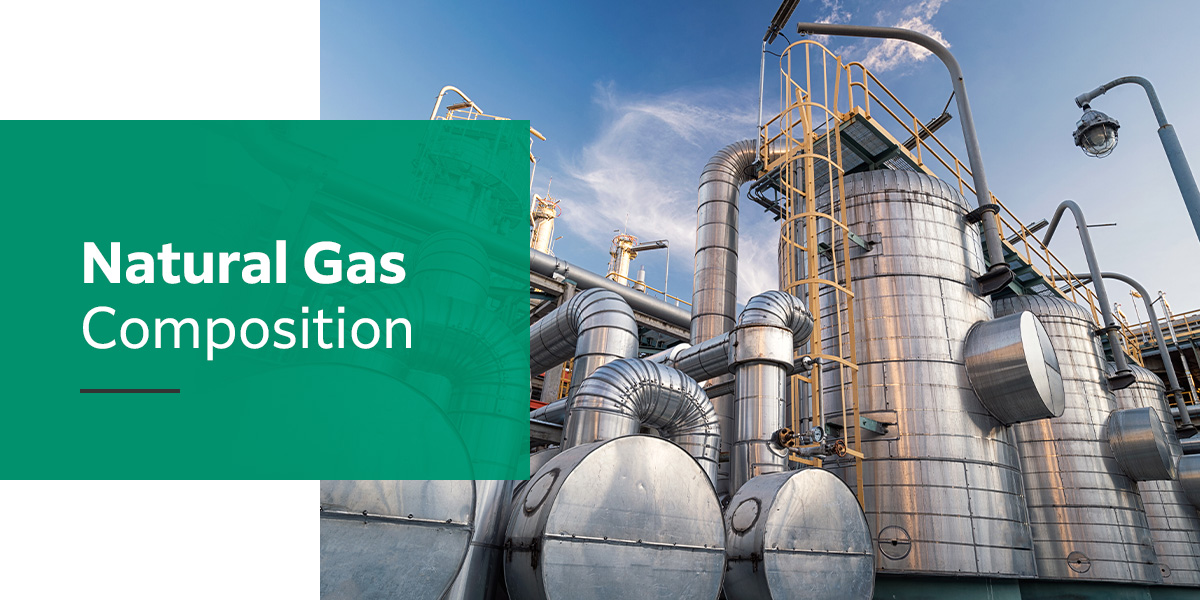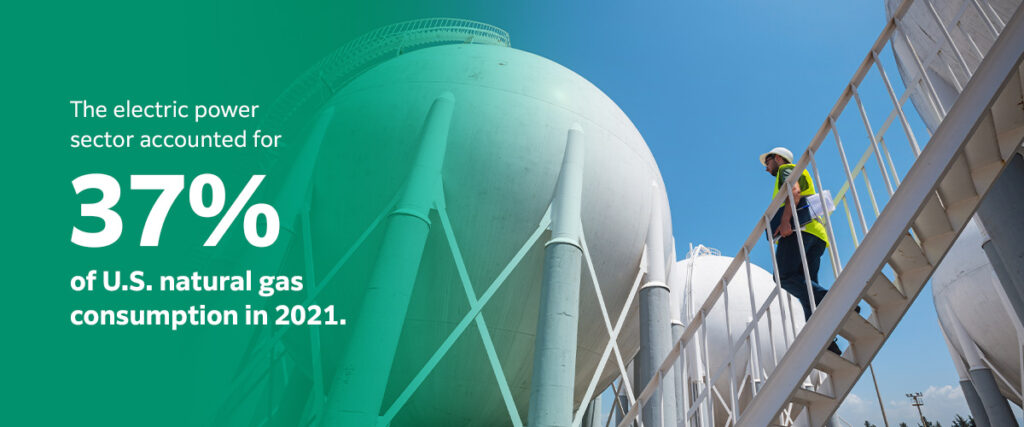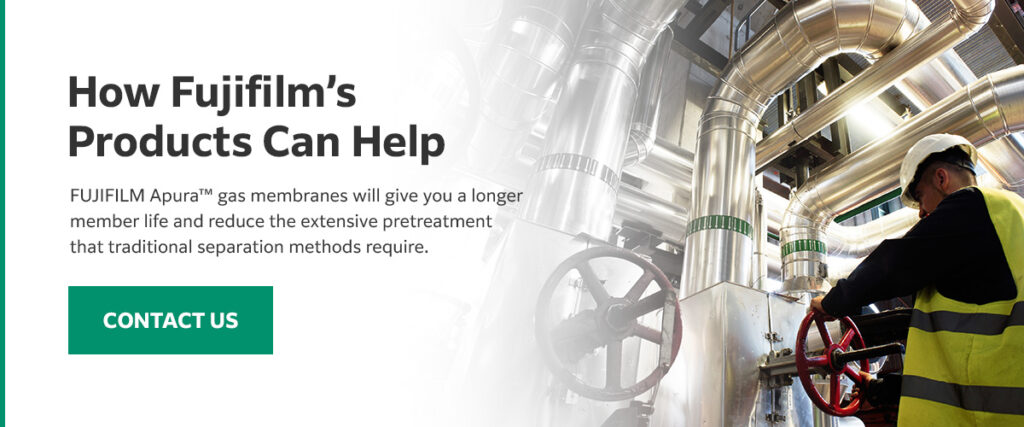
Jump to:
Natural gas is an efficient energy source and an important element in our everyday lives. Various industries throughout the U.S. use it to fuel their daily operations. However, the chemical components in natural gas can sometimes make it unsuitable for environmental regulations regarding carbon dioxide emissions and contamination levels.
Before natural gas can meet quality standards for sale and transportation, it must be stripped of certain impurities that can cause corrosion in gas pipelines and toxicity exposure in humans. Below, we’ll discuss what’s in natural gas and what compounds and contaminants must be stripped out before it’s sold, transported and used in different applications.
What Is in Natural Gas?
Natural gas is a fossil fuel that has been forming for millions of years deep below the earth. The exact composition of natural gas varies depending on its location. Because it started as a mix of organic matter, every source of natural gas has varying amounts of each chemical component. In its natural state, natural gas is colorless, odorless, non-toxic and nearly invisible.
Natural gas is primarily composed of hydrocarbon gases, organic compounds of hydrogen and carbon. Methane, a chemical compound containing four hydrogen atoms and one carbon atom, is its most prevalent compound. Other hydrocarbons typically found in natural gas’s makeup include:
- Methane
- Ethane
- Propane
- Butane
- Pentane
- Hexanes+
- BTX (Benzene, Toluene Xylene)
Wet vs. Dry Natural Gas
When the composition of natural gas contains mainly methane, it’s considered ‘dry’ or consumer-grade. ‘Wet’ natural gas still includes its heavier hydrocarbons.
Ethane, propane, butane and higher hydrocarbons must be removed from natural gas’s makeup before the gas can go to the end-user. However, these other hydrocarbon elements — valuable by-products of natural gas known as Natural Gas Liquids (NGLs) — can be sold separately and used for many different applications, including:
- Acting as an energy source.
- Providing raw materials for petrochemical plants and oil refineries.
- Improving oil recovery in oil wells.

What Is Natural Gas Used For?
A relatively clean-burning source of energy, natural gas can be used in many residential, commercial and industrial applications. Natural gas is highly flammable and combustible when mixed with air and exposed to an ignition source. Gas energy made its first U.S. appearance in 1816 when the city of Baltimore, Maryland, adopted the use of gas streetlights. By 1900, nearly 20 states were using natural gas. Today, we use it for heating and electric power generation on a global scale.
The electric power sector accounted for 37% of U.S. natural gas consumption in 2021, adding up to almost 12 trillion cubic feet of natural gas. The industrial sector was not far behind and consumed 33% of natural gas, while the residential and commercial sectors consumed 15% and 11% of this natural resource, respectively. Finally, the transportation sector consumed only 3%.
Here’s a brief overview of how each sector utilizes natural gas:
- Electric power: This sector uses natural gas to generate electricity and produce thermal output, such as heating and cooling.
- Industrial: In the industrial sector, natural gas serves as fuel for process heating and as a raw material to produce hydrogen, fertilizer and chemicals.
- Residential: Homes use natural gas for heating, water, cooking and drying clothes.
- Commercial: This sector utilizes natural gas for heating buildings and water, cooling equipment, operating refrigeration, providing outdoor lighting and as fuel for heat and power systems.
- Transportation: In transportation, natural gas serves as fuel for vehicles and operating compressors that move the gas through pipelines.
Natural gas is lighter than air, producing water vapor and small concentrations of nitrogen oxides and carbon dioxide when burned. However, when natural gas burns improperly, it can produce a poisonous, deadly gas known as carbon monoxide. Without removing harmful chemicals, impurities and contaminants of natural gas, consumers couldn’t use natural gas to power all these important functions.
Composition of Natural Gas
Natural gas must undergo chemical processes before it’s safe and practical to use. One of these processes is known as gas sweetening, which involves minimizing natural gas’s sulphuric content and stripping out acidic components that can corrode pipelines. The natural gas emerges from the sweetening process with those compounds removed or reduced to an acceptable level.
Carbon dioxide and hydrogen sulfide are some of the compounds that processing must remove from natural gas. These acid gases act as environmental pollutants, making it difficult to use natural gas in its raw state. Processes like gas sweetening help regulate emissions and limit the release of toxic gases into the environment.
Depending on how the natural gas will be used, an odorant known as mercaptan is sometimes added to the compound. This odorant acts as a critical safety measure because it can help people identify a gas leak by its distinct smell, which is similar to the scent of rotten eggs.
Why Shouldn’t Certain Chemicals Be in Natural Gas?
Impurities like carbon dioxide and hydrogen sulfide make the gas unusable in its natural state. Removing these acid gases allows the natural gas to meet environmental and human welfare standards for pipeline design and consumer requirements. For natural gas to be purchased and utilized, it must undergo processing for safe operation.
Many compounds in natural gas, such as sulfur, can form acids in the presence of water. Those acids can lead to corrosion in pipelines and other equipment. Internal corrosion is one of the main concerns for pipeline safety as it can cause leakage and other problems. Some of the chemicals that processing removes can also be highly toxic to humans at elevated concentrations and even cause death with inhalation or excessive exposure.
How Fujifilm’s Products Can Help
The gas separation process requires the right equipment, chemicals and products to ensure the natural gas can comply with emissions and quality standards for end-users. At Fujifilm, we rely on cutting-edge technology to provide our customers with effective products and services that contribute to advancements in environmental and human welfare. Our gas separation membrane products contain multi-layer coatings and innovative polymer technology that offer high-quality performance in various applications such as natural gas sweetening.
FUJIFILM Apura™ gas membranes will give you a longer member life and reduce the extensive pretreatment that traditional separation methods require. If you’re interested in improving your gas separation process, contact us today. Stop replacing membrane modules and losing hydrocarbons — get Apura™!














